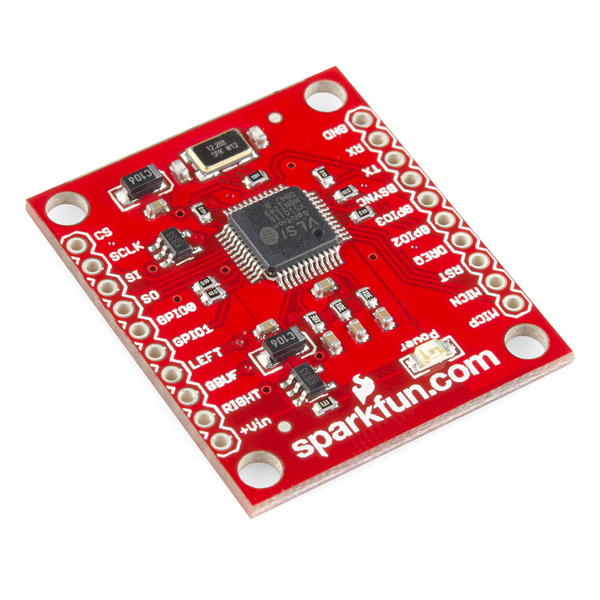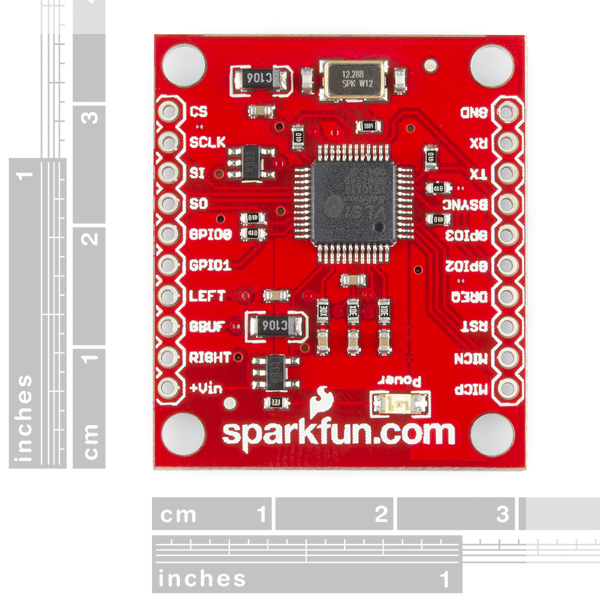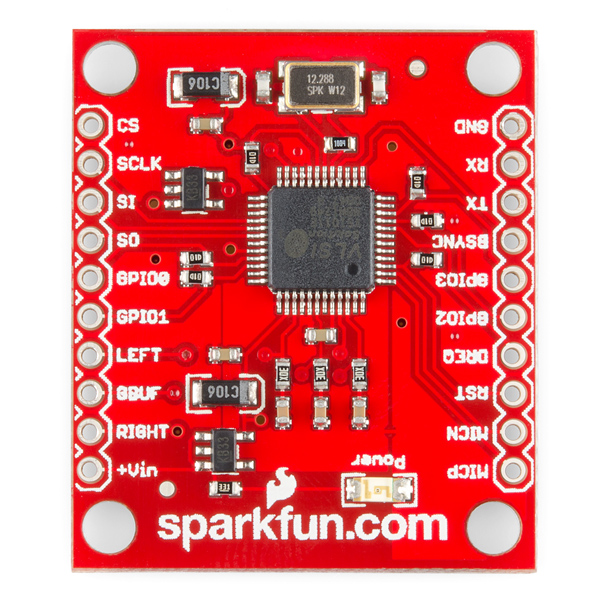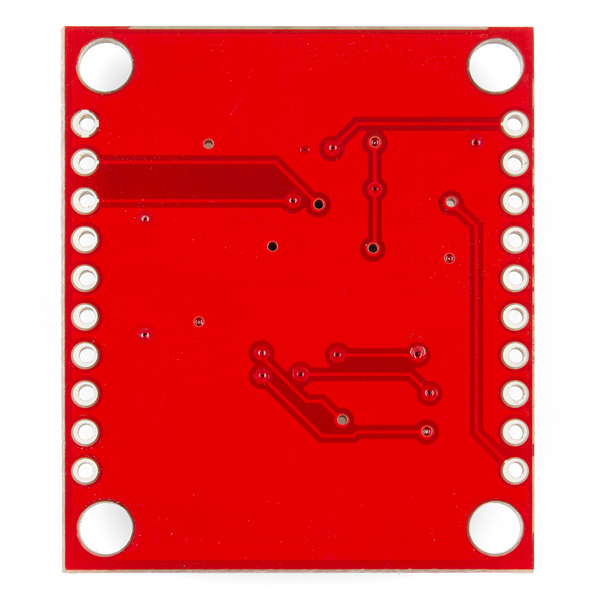SparkFun MP3 Breakout - VS1011E-L
The VS1011 is a great MP3 decoder, and with this breakout board, it's easy to drop it into any project. The VS1011 is capable of decoding MPEG 1.0 & 2.0 audio layer III (MP3) and WAV (PCM + IMA ADPCM) formats and can drive 30 Ohm headphones with no additional power supply.
- Separate Audio and Digital 3.3V supplies
- Onboard 12.288MHz oscillator* 1.4x1.2"
- 1.1" between headers
- Schematic
- Eagle Files
- Datasheet (VS1011)
- Example Config Code
SparkFun MP3 Breakout - VS1011E-L Product Help and Resources
Core Skill: Soldering
This skill defines how difficult the soldering is on a particular product. It might be a couple simple solder joints, or require special reflow tools.
Skill Level: Rookie - The number of pins increases, and you will have to determine polarity of components and some of the components might be a bit trickier or close together. You might need solder wick or flux.
See all skill levels
Core Skill: Programming
If a board needs code or communicates somehow, you're going to need to know how to program or interface with it. The programming skill is all about communication and code.
Skill Level: Competent - The toolchain for programming is a bit more complex and will examples may not be explicitly provided for you. You will be required to have a fundamental knowledge of programming and be required to provide your own code. You may need to modify existing libraries or code to work with your specific hardware. Sensor and hardware interfaces will be SPI or I2C.
See all skill levels
Core Skill: Electrical Prototyping
If it requires power, you need to know how much, what all the pins do, and how to hook it up. You may need to reference datasheets, schematics, and know the ins and outs of electronics.
Skill Level: Rookie - You may be required to know a bit more about the component, such as orientation, or how to hook it up, in addition to power requirements. You will need to understand polarized components.
See all skill levels
Comments
Looking for answers to technical questions?
We welcome your comments and suggestions below. However, if you are looking for solutions to technical questions please see our Technical Assistance page.
Customer Reviews
No reviews yet.





What are the MICP and MICN pins on the VS1011e? I noticed that they are pin-outs for this break-out board, but the VS1011e data sheet doesn't list their purpose or function.
electret microphones have DC bias on them,
MicP is positive, MicN is negative
What´s the voltage level must be applied at VCC?
Hi! Wondering if it's been considered to have a tutorial or example on how to get this working with an Arduino? The skill level for this is Rookie and competent in programming. I thought I was both, but kinda lost. I'm muddling along, just wondering if there isn't an easier way.
The serial digital audio interface on the VS1011 is it I2S or something else?
I'm wondering what kind of interface I have to connect the serial audio data interface to on my microcontroller.
the CI VS1011 is included with the board?
Do any breakout boards exist which can decode FLAC? I'm planning on building an electronic jukebox based on a Teensy processor and some SD-flash storage.
Exist? absolutely. Look for 'VS1053b breakout board' SFE carries one, but I'm not sure if the lack of 'b' there is important (check the datasheet) - product page doesn't mention FLAC.
The VS1053b supports FLAC through a software (for the chip) plugin: http://www.vlsi.fi/en/support/software/vs10xxpatches.html
There's also the VS1063 - a newer version of much the same chip. Supposedly pin-compatible. SFE carries a VS1063 breakout board but again no mention of FLAC ( while VLSI themselves certainly do: http://www.vlsi.fi/en/products/vs1063.html )
This guy at youtube.com/user/Rock202Star202 made his controller available to buy at
http://cgi.ebay.ca/ws/eBayISAPI.dll?ViewItem&item=251220606624
That is the 40-PDIP.
The TQFP is available at the link below.
http://cgi.ebay.ca/ws/eBayISAPI.dll?ViewItem&item=251221507707
Sparkfun staff, pick it up.......
Have you ever considered making an SMD version of this module or a newer VLSI chip (without mounting holes)? Something like the bluetooth modules but with 0.1" spacing for easy soldering. Would be really nice to just use one SMD module right into our projects and avoid soldering those tiny components.
We do carry a very similar board for the VS1053 as well as MP3 and Musical Instrument (MIDI) Shields. That's an interesting idea to make SMD breakout boards, but we always figured that if you're that into SMD, you can probably use the bare parts as-is.
I do not agree with you entirely: it's way easier to solder a 0.1" spaced SMD than LQFP100 or those tiny crystals that this board carries. You should consider making more SMD modules. It's just an idea ;)
If you're desperate, you could always slice this board halfway through the headers on both sides, ending up with the same half-hole SMD construction that the RN-4X Bluetooth modules use. Personally, I'd just stack it with M-M PTH headers.
As I said, it's just an idea. I'm not desperate at all :P But it would be nice to have more options (and not just for this module).
Rock202Star202 has completed a fully functional MP3 and WAV player using the VS1011E, check out the link below:
http://www.youtube.com/watch?v=ukhvJv_-bIc
Enjoy.... Sparkfun pick the Programmed MCU up.... Wicked project...
It'd be helpful if the item description made it clear whether this is a bare board or populated.
It is populated. Hope that helps anyone who is also curious!
Has anyone gotten these to work with an Arduino? I've been able to hook up the breakout board to the Arduino via a 74LVC245. I can read and write registers with SCI and initiate a sine test with SDI but when I send MP3 data via SDI it pretty much just locks up. Sometimes I'll get something that sounds like its trying to decode but its usually garbled or just silence. It takes a power recycle to get the chip to respond again. Here's what I've done in software:
Set the clock to 0x9800 like the data sheet says for a 12.288 Xtal SPI is MSBFIRST, SPI_CLOCK_DIV8, SPI_MODE0 Set mode to SDINEW Drop CS low for SCI enable and drop XDCS (BSYNC) low for SDI enable.
My guess is it has something to do with byte syncing for SDI. But the 8 byte SDI tests sequences work. I check DREQ to make sure its high before sending but I rarely see it go low.
If anyone has had any luck I'd love to hear what you did.
Check out this guys YouTube video with the VS1011E. He says he will have the programmed IC ready for purchase soon for anyone wanting to create an MP3 player project. Check it out yourself.
http://www.youtube.com/user/Rock202Star202
Check Out Part 4 of the video, just been added and has PCB available.
Awesome job, hopefully Sparkfun will pick up this guys controller.
Can this stream MP3 and other audio formats ?
Some examples for pic
Sparkfun PCB Designers,
While I appreciate having mounting holes on a PCB, they are of no value if there isn't room for the screw head. Try putting a screw or bolt through the hole that is big enough to not fall through, and you'll find that it contacts the headers at the end. If that bolt is grounded and hits the Vin pin, very bad things happen.
I recommend that SparkFun take a look at every PCB they make and update the mounting holes. I suggest a 1/8" hole surrounded by a 1/4" clearance area for the screw head. Only then will the mounting holes be useful and safe.
Also, how about having having the legends for the header pins all be readable from the same orientation? Having to turn the board 180 degrees to read the legends on the opposite side of the board is a huge pain. I honestly can't imagine the designer who thought that having the legends flipped 180 degrees vertically was a good idea. If it looks bad on the PC screen while you're designing it, then it won't get any better when put into production.
Finally, I'd suggest putting the product ID on the board so that users can determine what it is at a glance. For example, all the MP3 breakout boards look similar. I wouldn't have to grab the the magnifier headgear to check out the part number if it was silkscreened on the PCB somewhere.
Beware that the Right and Left channels are reversed. There is an error on the board and schematic (the nets are incorrectly named in the schematic).